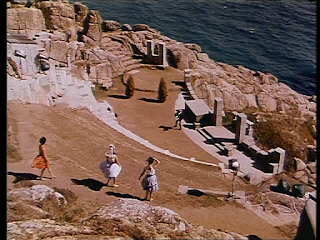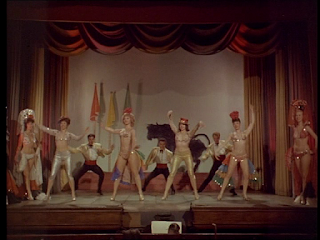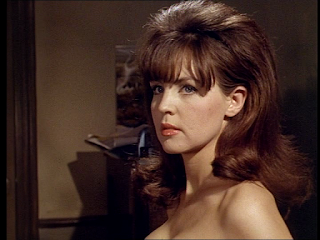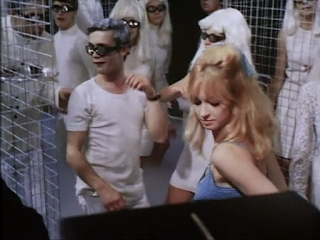After being a double bill in 1966, these two exploitation films are released together again on a DVD that appeals to a cosy ideal of nostalgic titillation, an almost innocent time in which filmmakers had to be artful in sneaking sex into documentary and drama. Now there is also the cultural context that makes these films worth watching as well as the female nudity and the Internet Movie Car Database goes a bundle on the 1959 Austin A40 MkI, 1958 Bedford CAL Camper Mk2, 1956 Vauxhall Velox and others featured in Naked… whilst others are merely keen to see Pamela Green’s chassis (oh, come on!).
Naked as Nature Intended is the better of the two and, oddly enough, the most defensible in terms of an historic documentation of contemporary mores and holiday preference even though its stall is clearly laid out. Produced and directed by the legendary George Harrison Marks it was a natural extension of his soft care 8mm work with girlfriend Pamela, following the relaxation of censorship rules. There’s a fascinating biography of Marks on IMDB from Gav Crimson which sets out his career trajectory from musical hall to hardcore and it’s also interesting that he made films for deaf children featuring Green and others. He was a filmmaker and not a pornographer although that phrase is so loaded isn’t it?
Naked is ostensibly an advert for nudism and an excuse to show as much of Pamela Green and her co-stars as possible but it also fits in genuine travelogue. Pamela is Pamela, one of three young women who are heading off for a break in Cornwall, her flatmate, Petrina (Petrina Forsyth) and their buddy Jackie (Jackie Salt… sensing a pattern in the naming of characters). They get petrol from a station where two other “girls” Angela (Angela Jones) and Bridget (Bridget Leonard) are also off west and the films follows their paths to the same destination. The dirty mac brigade need to be patient as it’s going to take almost two thirds of the film to get to see a lot of more of the five…
First up the girls see Stonehenge for a romp and then down through Devon for the beach at Clovelly and on to Cornwall for Tintagel and the Bedruthan Steps. There’s a lovely scene at the Minack Open Air Theatre where the trio interact with the rehearsing actors, so much pulchritude in Penzance.
They finally arrive in the golden sands near Land’s End where they meet Petrina and Bridget who persuade them to have a go at nudity and there’s lots of fun with an inflated beach ball and Pamela rolling around in a rock pool. It’s all very tastefully done – health and efficiency – and then they go to the nudist camp where P & B stay, to meet the residents and indulge in more swimsuit-free sport. This section was filmed at the Spielplatz Sun Camp nudist park in sunny Hertfordshire with lots of nudist extras who are generally less statuesque.
 |
| The Minack Open Air Theatre |
Nudism seems to equate to freedom and there’s no “Cor blimey” moments just undercurrents, Anne and Bridget seem to be palling up and there’s a sense that everything goes when you’re nude with all the barriers down. The framing narrative was pretty much the only way the censors would pass a film with this much naked flesh and even than a clip of Pamela coming out of the shower in her flat was cut in case it gave the impression that she was in a relationship with Anne.
So, with its vintage home-movie charm, clean endless beaches and conscious asexuality, Naked feels nostalgic for its attitudes alone but there are some great sights on view not to mention the history and splendour of the Cornish coast!
 |
| Pamela Green was famously in Michael Powell's Peeping Tom |
Five years later in London, Pauline Collins was to encounter a far seedier side of the sex industry as her character tries to make her way as a showgirl at the famous Windmill Theatre. Directed by Arnold L Miller, Secrets of a Windmill Girl also has a secondary worth by capturing some of the acts who played at the theatre when it was still a mix of cabaret and coy striptease. There are full musical numbers, male comics and singers crooning over bongos to go with the full-scale musical productions used as the pretext for tableaux and fan dances still deployed in the mid-sixties to get past archaic regulation about too much “show”. If you’d gone in search of a raunchy night of nudity, you’d find yourself waiting through quite a lot of cabaret to get to the odd glimpse beyond the fans…
You’d also have to sit through the story of the “Windmill Girl” Pat, played by Collins who, even in her first feature film, is quite the actress, and, even with this script. The story starts with a drunken Pat getting into a sports car with an inebriated young man who, as the credits roll, proceeds to drive them both to their deaths. The police are called and Inspector Thomas (Derek Bond) then starts to interview her flatmate, Linda (April Wilding) who begins to recount the whole story…
 |
| They never closed you know... |
Linda and Pat were childhood friends who always dreamed of dancing and ended up auditioning for the Windmill where Pat’s natural vivacity gets her selected and helps her to persuade Stage Manager, Mike (young Martin Jarvis) and lead dancer Peter (Peter Gordeno, later to captain the Skydiver One in Gerry Anderson’s UFO!) to hire them both. The two become introduced to a whole new world, attending parties with theatrical types including Harry (Harry Fowler) an impresario who wants to “help” her career and an older woman who shows an unusual interest in getting to know Pat… everything in code still!
The party has music from a statuesque folk singer played by Dana Gillespie, who deserves a post all of her own, she had been British Junior Water Skiing Champion in 1962 and met a 17-year-old David Bowie at London’s Marquee Club in the early sixties and went on to be his girlfriend, muse and friend into the seventies and the solo LP he producer for her, Weren’t Born a Man…
 |
| Dana Gillespie |
Back at the Windmill, we see more rehearsing – including an uncredited Aimi MacDonald – but we see very little of Pat and Linda actually dancing which creates a disconnect between the performances shown – the actual dancers and singers – and the rest of the story. It’s like a documentary mixed with drama and is less cohesive in this respect than the Naked film.
We also know exactly where things are heading courtesy of that opening and that a means will need to be found to lead to Pat’s downfall… the Windmill gradually goes out of style as raunchier reviews are allowed and the old song and dance routines are less important than pure striptease. The company breaks up - the theatre that "never closed" actually did in 1964 - and Pat, who had been naively hoping for a sugar daddy to give her a big part, gets left taking her clothes off in the back room of bars while Linda gets work in the legitimate theatre.
 |
| Pauline Collins and April Wilding in Rupert Street Market, Walkers Court at the back |
No matter how well Collins emotes, it’s hard for even her to convince with some of the lines and we’re left with a rather unconvincing progression into drunken party animal. This is even more jarring when you look at how professional the Windmill set up had been… this is not the secrets of a Windmill Girl but the unfortunate decision to accept a lift from a drunken man by an ex-Windmill Girl…
The film is also morally conflicted as it shows the full
Windmill experience and not the striptease one which it implies is the cause of
Pat’s downfall; “it’s you watching men who drove her to this!”. But maybe it's also mourning the demise of the old Revudeville professionalism in a time of growing sleaze?
 |
| One of the former Windmill fan dancers recreates her work for the film. |
Dusty Verdict: All this said, Windmill Girl has
its moments and if you like fan dancing look no further. By the same token, if
you want beautiful naked bodies playing in the sand then you’ll like As
Nature Intended… In fairness to Windmill Girl there is no doubt that the
industry around the lower levels below the Windmill, was full of abuse and desperation
so the story isn’t that off beam, but it could have been done better.That said, it's historically important because it captures some of the dancers and comedians who worked at the Windmill. There's also some grand footage of old Soho, familiar places that have changed so much and yet still remain... the old Windmill is still there, it's future as uncertain as every theatre in these strange times.
The DVD is available from Amazon and others, good value if undemanding and don’t forget all those marvellous cars!















































